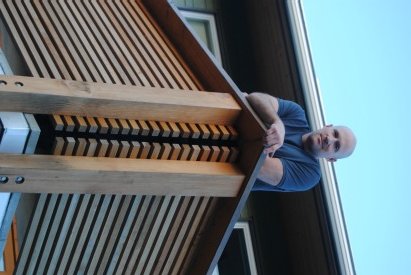
By Gagandeep Ghuman
Published: Feb. 11, 2012.
At first, Adam Smith’s home looks no different from other homes in the Amblepath subdivision on Government Road.
But a closer look reveals the subtle and not-so-subtle differences that make this home unique in this subdivision.
Adam Smith has put in a lot of painstaking effort to make an environmentally sustainable home that will soon be Leadership in Energy and Environmental Design (LEED) Gold certified.
The singularities jump at you in the driveway.
There is concrete instead of grass in the front and backyard.
The plants in the driveway are dry and drought tolerant.
“They have no irrigation demands. They will thrive here in any condition,” he says.
A small opening on the driveway floow leads to the storage where the rain water is stored, and later well-used in the house.
 Step back from the driveway, look towards the roof, and you will see spindly vacuum tubes joined together to trap solar heat.
Step back from the driveway, look towards the roof, and you will see spindly vacuum tubes joined together to trap solar heat.
“You have to be committed to build this kind of a house, but it’s easier than what most people think,” Smith says.
Smith built his home in Squamish in 2010, after moving to town from North Vancouver.
Environmental stewardship was his incentive.
“For me, it was about social conscience, and about being a small part of the solution,” he said.
It’s a mistaken belief that building a ‘green’ home is prohibitively expensive, he added.
It might cost 10-15 per cent more, but it adds more value to the house, and the savings on reduced energy consumption make up for the extra money spent.
“My hydro bill is half of what most people would pay in this subdivision,” he noted.
Even if you don’t target LEED status, just putting away 15 per cent for building green can make a difference, he says.
Smith, of course, had a thick binder to guide him towards the demanding goal of achieving LEED Gold status.
The LEED Green Building Rating System recognizes performance in five key areas.
They are sustainable site development, water efficiency, energy efficiency, materials selection, and indoor environmental quality.
Smith used local reclaimed material, and brought new material only from Lower Mainland communities close to Squamish.
The home is insulated well-beyond the building code, and a passive solar design rejects solar energy in the summer, but imbibes it the winter.
A Heat Recovery ventilation or HRV provides fresh air and improved climate control, while also saving energy by reducing heating and cooling arrangements.
Smith estimates he spent about 15 per cent more in trying to bring about the changes, but he is confident he will make a return on the house, even if that wasn’t his motivation in building green.
Despite the extra cost, he was able to built it well under $200 a square foot.
“We can make a small change, and that is what I was hoping to do here,” he says.


Squamish climber says
Wait! Doesn’t this guy drive a big huge pick up truck with a snowmobile in the back??? snowmobiles pollute at a rate of 10 times that of a conventional car. And the Gm 2500 can’t be good either..
Adam says
Yes, Squamish Climber…. a builder drives a truck so material for jobs can get to the jobsite. That’s not an outrageous concept is it?
I think one trip in a DIESEL truck (the most efficient in it’s class) beats using a giant RONA truck to deliver materials, don’t you?
Pretty easy to throw rocks from behind an anonymous posting I guess…..